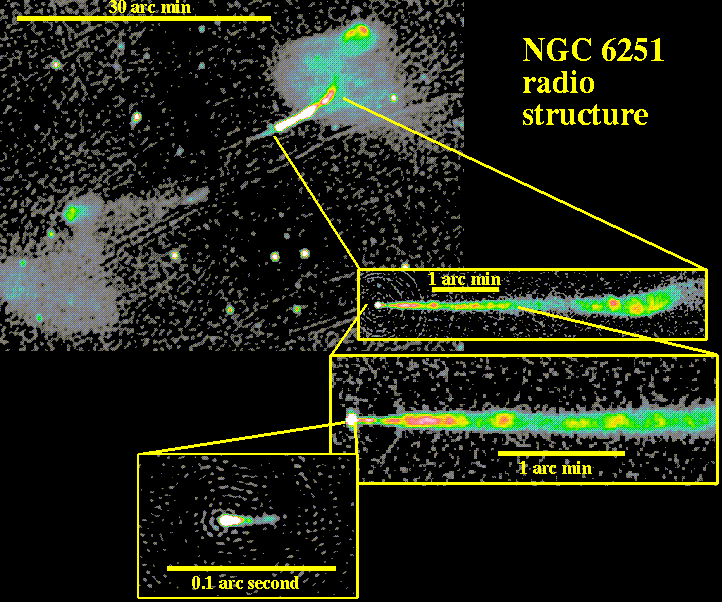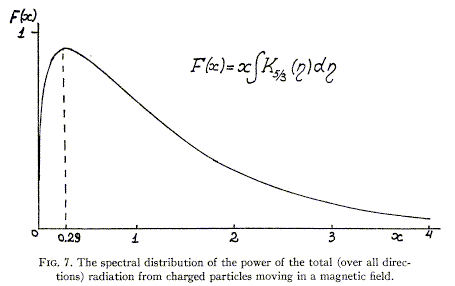
A close look at the structure of radio sources around active nuclei is shown in this montage of NGC 6251, ranging from the outer double lobes spanning nearly a degree on the sky (1.6 Mpc) to the innermost jet within a parsec from the core:

The spectral and polarization properties of the radio emission (and in some cases emission at other wavelengths as well) indicate an important role for synchrotron radiation (also known in some areas as magnetobrehmsstrahlung). This process has been discussed exhaustively by
This radiation is produced by relativistic electrons spiralling in a magnetic field. We see only the electrons; protons are less efficient radiators by a factor mp/me. The electrons undergo acceleration a =(e/m) v x B where all three quantities are vectors (this is the relativistic Lorentz force). The particle path is a slowly widening helix. A distant observer sees pulses of radiation, beamed into a cone by the Lorentz transformation. Radiation from monoenergetic electrons is spread by this process over a large frequency range, as shown in Fig. 7 of the Ginzburg & Syrovatskii 1965 review (from the ADS):

peaked at

in which B^ is the field intensity modulated by the sine of the pitch angle of motion with respect to the field lines. The particle distribution in angle needs to be known - a frequent assumption is that of pitch angle scattering happening rapidly compared to the radiative-loss rate. Observed sources generally have a power-law spectrum F n = F0 n -a with a ~ 0.7; a is the spectral index. Beware that the sign of a may take either convention. It follows from convolution that a power-law intensity distribution for synchrotron radiation is produced by a power-law distribution of electron energy over the relevant range

This distribution is similar to that of local cosmic rays (and for that matter the energetic particles producing bogus photon detections in CCDs and the like) and implies some kind of self-similar or scale-free acceleration mechanism. Energy losses due to synchrotron radiation will affect higher-energy particles first, leading to a steepening spectrum with time in the absence of further energy input (Kardashev 1962 Sov. Astron. 6, 317). Any process restricting the number of high-energy particles (such as a genuine cutoff in acceleration) will produce a similar instantaneous effect, though different time dependence. There has been discussion as to whether synchrotron aging has in fact been observed in particular radio sources (as in, for example, the M87 jet on scales of a few parsecs).
The synchrotron lifetime of particles whose radiation peaks at nc is

B^ is typically 10-4 gauss, so radio-emitting particles have ts ~ 106 years. Optically-emitting particles have ts as short as 30 years. In some places, this implies a role for so-called in situ acceleration to the highly relativistic energies (G ~ 106) for the observed radiation. There is an NRAO workshop proceedings volume dealing with this point (Physics of Energy Transport in Extragalactic Radio Sources, 1984, ed. A.H. Bridle and J.A. Eilek), with more recent results appearing in the PASP Conference Series volume (100) on Energy Transport in Radio Galaxies and Quasars from the 1996 Tuscaloosa workshop. There is a vast literature on properties of synchrotron sources, such as polarization and expected aging of a plasma as it loses energy via this mechanism.
Radio galaxies and quasars share many structural properties at radio frequencies (i.e. from a few mm to some meters in wavelength). The double sources come in two basic flavors, the Fanaroff-Riley (MNRAS 167, 31) types. Type I sources have lower luminosity, two-sided jets, and diffuse edges all around (so-called relaxed doubles). Type II sources have hot spots on the outer edges (so-called edge-brightened sources), higher luminosity, and either one-sided jets or pairs with very different intensities. About 70% of sources in a flux-limited sample like the 3CR fall into one of these categories. It can be shown from rotation-measure distributions that the jets are on the side facing us (sometimes called the Laing effect), so that Doppler boosting by relativistic bulk motion in the jets is a straightforward explanation (if not clearly sufficient) of the asymmetry. Note, though, that there is little real data on how fast the jet material is actually moving, and how the observed jets are related to the true particle distribution (see disgruntled comments by Keel 1987, IAU Symp. 121, Observational Evidence of Activity in Galaxies, p. 255). VLA, Westerbork (WSRT), and Merlin data have shown that the lobes of double sources can contain rich internal structure, from the tangled tubes of Cygnus A to rings in Hercules A (3C 348). To some extent, we are seeing the magnetic field configuration more than the particle distribution, since the synchrotron emissivity is a strong function (B2) of the field strength. The distinction between type I and II sources is usually thought to represent one of jet speed or Mach number; FR II sources look supersonic. Note that jet simulations indicate that the visible sources are probably surrounded by a cocoon, including backwards-flowing material, which is only seldom detectable. Morphologies such as FR II objects are reproduced only when the plamsa expands into an external medium with non-negligible pressure.
Last changes: 10/2000 © 2000